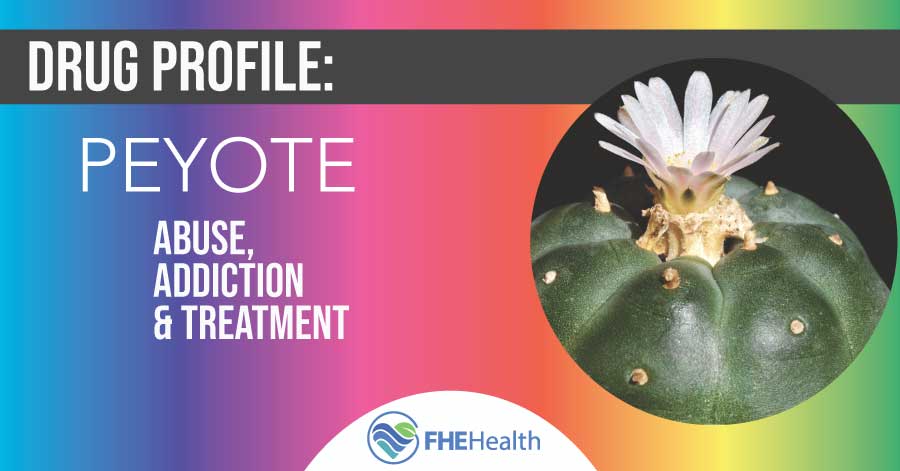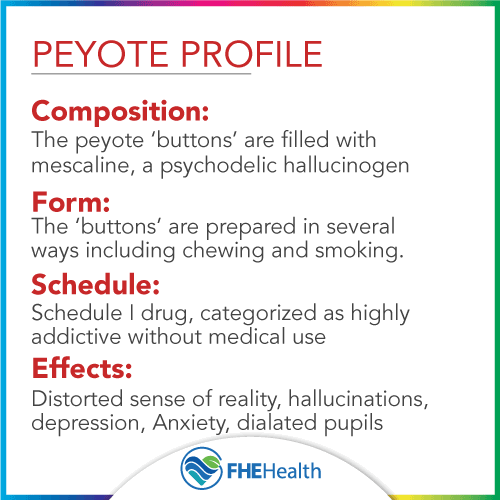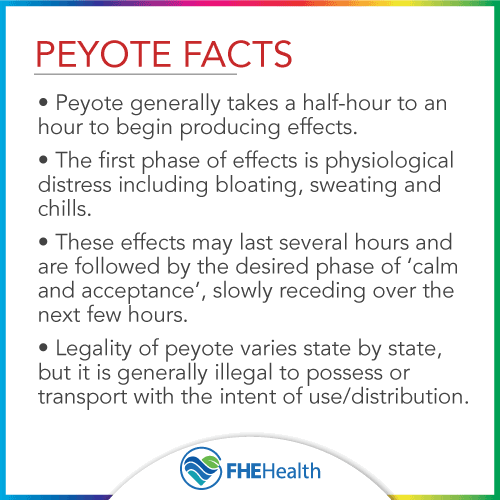
Though used in religious ceremonies and medicine for several thousands of years among Native Indians in Mexico and North American tribes, peyote and its psychedelic abilities have always sparked controversy. The U.S. government attempted to ban its use but was met with strong resistance from native tribes. Today, the Native American Church uses it legally in its religious practices, thanks to changed legislation.
But, according to the Controlled Substances Act of 1970, which classifies peyote as a Schedule I drug, recreational use of the drug is illegal. The famous French playwright Antonin Artaud wrote “The Peyote Dance” following his experience with the drug and with native tribes in Mexico.
What is Peyote?
 A bluish-green, spineless cactus that grows low to the ground, peyote contains small disc-shaped buttons filled with mescaline, a psychoactive hallucinogen. Before consuming, users must cut, dry out and soak these peyote buttons.
A bluish-green, spineless cactus that grows low to the ground, peyote contains small disc-shaped buttons filled with mescaline, a psychoactive hallucinogen. Before consuming, users must cut, dry out and soak these peyote buttons.
Peyote can cause hallucinations and altered visions, changing your perception of reality. It usually takes a long time to grow but some cultivated specimens may grow faster. Peyote is native to South Texas, Mexico and Peru and is often found in limestone-rich areas. Some names used for peyote include “Lophophora williamsii,” “mescal,” “tops,” “buttons” and “nubs.”
What is Peyote Used for?
Traditionally used for religious and medicinal purposes, peyote is banned for recreational use because of its strong hallucinogenic properties.
Apart from religious practices, the Native American Church also uses it for communicating with spirits, envisioning the future and treating illnesses. Native tribes believe that peyote can treat several conditions, including:
- Childbirth pain
- Fever
- Diabetes
- Pain
Those outside the church wanting to try peyote are likely looking to exploit its hallucinogenic properties to escape reality.
How to Take Peyote?
Known to evoke visions and create heightened awareness, peyote was used to cure physical, spiritual and social evils. Peyote is consumed in several ways:
- Chew it or suck it before swallowing
- Brew it in tea
- Create a powder and store in capsules
- Roll it into a leaf or tobacco and smoke it
The powdered version, generally referred to as mescaline, is the more pure form and is used to create pills or even injectables. A peyote trip lasts for up to 12 hours depending on the strength of the drug consumed.
What are the Side Effects of Peyote?
 Though illegal, people continue to use peyote. Vivid hallucinations are common with users who report altered views and visions. Recreational use can also lead to several side effects:
Though illegal, people continue to use peyote. Vivid hallucinations are common with users who report altered views and visions. Recreational use can also lead to several side effects:
- Anxiety
- Heart rate variations
- Breathing difficulties
- High blood pressure
- Dry throat
- Lack of concentration
- Lethargy
- Shivering
- Sweating
Drug users may go through moments of joy and terror with heightened emotional experiences. Some may experience a good peyote trip, while others a bad one. Even during a ‘good trip’, it is proceeded by a period of physiological distress followed by feelings of calm and relaxation. But a bad trip may cause you significant distress where you could even end up hurting yourself.
Is Peyote Legal?
Peyote is illegal in all of the U.S. states and territories, except in the Native American Church. If you are caught illegally using the drug, you may face jail time or heavy fines.
In some U.S. states, any religious organization may use peyote, while in others only the Native American Church is allowed to do so. From a recreational perspective, peyote is completely illegal.
What is Peyote Addiction?
As a hallucinogen, peyote alters nerve cell communication and changes the level of serotonin in the brain. Since serotonin is responsible for your thinking and perception, constant peyote use impacts behavior. If you take peyote, you may feel depressed as the effects wear off— and you could lose your sense of reality.
Repeated use of peyote for an extended period of time can change and alter brain chemistry. The more you use it, the more tolerance you will develop, especially in a 10-day period following use. This may cause you to lose sensitivity to its effects and in turn seek larger doses. But with peyote, though tolerance starts quickly with use, it doesn’t last too long. If you stay away from the drug, your original sensitivity will return.
At the same time, while peyote is a mind-altering substance, it doesn’t have the same composition as other highly addictive drugs. This makes it easier to overcome your use of the drug.
Though popular belief is that all psychedelic use increases the risk of a psychotic episode and potential brain damage, McLean psychiatrist John Halpern conducted a study that contradicts this view. Conducted on American Indians, the study found no evidence of brain damage or psychological problems among those who used it regularly as part of their religious practices. Since this study related specifically to peyote in religion, researchers stressed that these results may differ for people using the drug recreationally.
Peyote Addiction Treatment
 Peyote users are more psychologically dependent on the drug rather than physically dependent. While this kind of dependence is treated less seriously than an opioid dependency, it is cause for concern and there are signs to look out for, including:
Peyote users are more psychologically dependent on the drug rather than physically dependent. While this kind of dependence is treated less seriously than an opioid dependency, it is cause for concern and there are signs to look out for, including:
- Investing time and money to access peyote
- Increase in conflicts with close people
- Increased isolation
- Dissatisfied with life without peyote
- Unable to stop use
- Taking peyote more often or increasing doses
- Missing out on work, education and social communication
No specific treatments exist for people addicted to peyote, but some therapies that help include cognitive behavioral therapy to create connections between feelings and thoughts, motivational interviewing to increase motivation to end drug use, and family therapy to help understand the effects of drug use on the family unit as a whole. Another therapy, contingency management, provides rewards for recovery-related activities.
Since peyote doesn’t have any risky withdrawal symptoms associated with it, most of these treatments do not require you to stay in a center for a detox period. Inpatient treatment is, however, beneficial to people struggling with addiction regardless of physical dependency.
Medical interventions and detox treatments are usually not necessary with peyote addicts. But people who are addicted may benefit from psychology therapy sessions and support groups to help fill any voids they feel that caused them to try these drugs in the first place.
It’s important to understand that recovery from peyote addiction doesn’t necessarily occur overnight. You must be patient and allow yourself enough time to get over your addiction so you can live a fulfilled life.
Irrespective of the harmless side effects and possible curing properties, peyote should not be used for recreational consumption.
If you or someone you love is addicted to peyote, never feel afraid to ask for help. At FHE Health, we have a team of professional counselors available 24/7 who can steer you in the right direction towards recovery. Give us a call at (866) 653-6220 and let us help!






